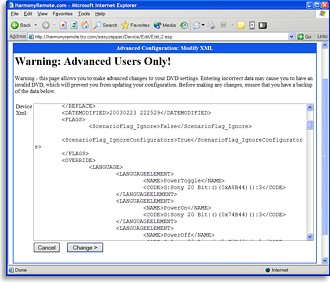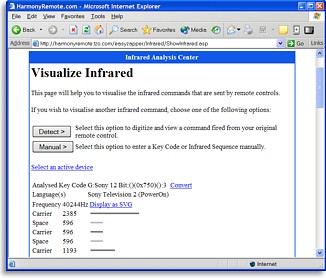|
...Continued from Page 7.

Viewing XML code.
|
Every one of my devices that the site claimed to recognise by the exact model number was either peppered with useless commands, or was missing important ones. For example, my ordinary satellite receiver was loaded with codes for TiVo DVR functions. The television, which was a new model on the market but still recognized by the site, had missing inputs, inputs that were only available on projectors, and various codes only applicable to other models. Unlike unrecognized devices, where you are able to teach only the exact commands specific to the model, the Harmony’s site forces the download of every function in it’s database on “recognized” devices, whether you want it or not. From reading the site’s help function there doesn’t seem to be any way to easily correct this situation.
While manually entered devices show every learned command and the infrared data to go with it in the XML file, database-driven devices only show your changes to the default setup. After much poking about I did locate a way to stop a device completely from using the database by selecting the infrared language as “Empty” during the optional “Characterization” process, but that forces the user to learn every single code from scratch. It’s also possible to force a complete user re-write of a device’s menu structure in XML, but that’s not exactly ideal either.

Analyzing an IR code.
|
While viewing the XML code for my totally taught device, I noticed a number of incorrectly learned infrared codes. Instead of merely storing a raw copy of the infrared code, the Harmony tries to interpret them into the original language, device and command number structure, ensuring completely clean transmissions. Some of these did not convert properly, instead remaining as large blocks of raw data. After entering the site’s special “Advanced” mode I found that it actually marks which commands were properly “analyzed” and which were “raw” – this information should probably be available in “Normal” mode as well.
A particularly interesting item under the aforementioned “Advanced” menu is the “Infrared Analysis Section”, which takes any infrared code and displays it visually in two different ways. It even converts Harmony-learned codes into Pronto hex code format and, you guessed it, lets you quickly insert Pronto hex codes into your Harmony configuration. Quite useful – but why is it buried so deep!
Activating Activities
After the site is satisfied that all of your devices are ready to go, it automatically begins the activity configuration utility. Most devices in your system will correspond to a new activity – a television adds a “watch television” activity, a DVD player adds “watch a DVD”, while a stereo receiver adds “listen to the radio”. Setting up an activity involves answering specific questions on how your system is configured. For example, with the television activity you must tell it which of your devices you use to watch television (TV, VCR, satellite, DVR, etc.) and which of your devices will control the sound.
Although most activities configured quickly, some inputs were not correctly configured for devices that pre-existed in the database – but this can be corrected without fuss during the setup process.
| 
